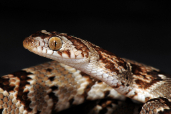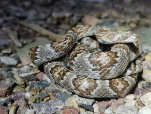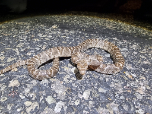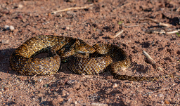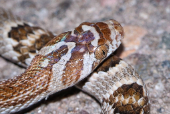Sonoran Lyre Snake (Trimorphodon lambda)
Description: Trimorphodon have been recorded from 18 - 47 3/4 inches in length. Most snakes encountered are 24 - 36 inches long. A slender snake with a broad head well-differentiated from the slim neck. The pupils are vertical, like those of a cat. The anal plate is divided. Coloring closely matches a snake's rocky habitat, from gray to light brown. There are usually about 28 large dorsal blotches with light edges and a pale crossbar in the center, and smaller irregular blotches on the lower sides. A lyre-shaped marking is present on top of the head. The underside is off-white or yellowish with dark spots.
Trimorphodon lambda Has fewer body blotches than T. lyrophanes. Fewer than 31 primary dark body blotches - average of 24. Body blotches are more widely separated than those on T. lyrophanes. The seventh and eighth blotches are separated by an average of four scale rows.
Habitat: Associated primarily with rocky desert locations, but found in rockless areas, also.
Range: Occurs in the United States and Mexico. The range extends from southern Nevada (Nye County) and extreme southwestern Utah (Washington County) south through much of Arizona (except for the northeastern quarter), southwestern New Mexico (Hidalgo and Grant counties), southeastern California (generally east of the Salton Trough region), Sonora, western Chihuahua (west of the Sierra Madre Occidental) to northern Sinaloa. The number of distinct occurrences has not been determined using consistent criteria, but the species is represented by a fairly large number of collection sites and locations. Secretive habits and occurrence in rough terrain that is difficult to survey effectively make it likely that this snake occurs in substantially more localities than are presently known.
Diet: Primarily lizards, but also known to eat small mammals, nestling birds, and snakes.
Reproduction: Not well known. Breeding probably takes place in Spring . Females are oviparous, laying a clutch of 10 or more eggs in Summer which hatch in late Summer and early Fall.
Status: Listed as Least Concern in view of the wide distribution, presumed large population, lack of major threats in most areas, and because it is unlikely to be declining fast enough to qualify for listing in a more threatened category.
»» Kingdom: Animalia - Animals
»» Phylum: Chordata - Chordates
»» Subphylum: Vertebrata - Vertebrates
»» Class: Reptilia - Reptiles
»» Order: Squamata - Scaled Reptiles
»» Suborder: Serpentes
»» Superfamily: Colubroidea
»» Family: Colubridae - Colubrids
»» Genus: Trimorphodon
»» Species: Trimorphodon lambda - Sonoran Lyre Snake
This article uses material from the Wikipedia article "Trimorphodon", which is released under the Creative Commons Attribution-Share-Alike License 3.0. Content may have been omitted from the original, but no content has been changed or extended.
|




